|
LEAVING CHELTENHAM …………..and all that was dear |
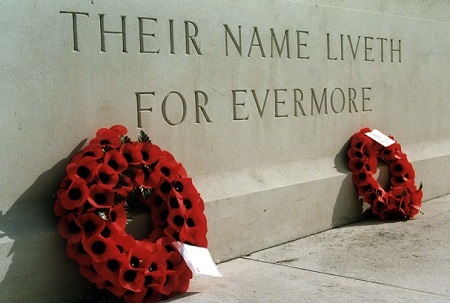
|
Remembering Arthur Allsopp |
|
A tribute to Gunner Arthur Ernest Allsopp, 133rd Battery, Royal Garrison Artillery, who died of wounds in France on 8th October 1918 |
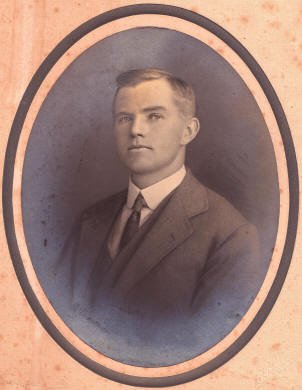 |
Arthur Ernest Allsopp was born in Cheltenham in 1889. His parents, George and Annie Eliza Allsopp, resided at 24 Victoria Street, St Paul’s, Cheltenham.
Prior to the war, he worked as a plumber, the trade of his father, for WT & RA Hunt, Builders, of Carlton Street off Hewlett Road, Cheltenham. He married Florence Louisa Hoyle in Cheltenham on 5th August 1911 and by the time he enlisted in the Army they had had two children, Imelda who was born in 1915 and Sydney, 1916. He enlisted into the Royal Garrison Artillery (Territorial Force) in Cheltenham and after training was posted to the 133rd Heavy Battery in France. Gnr Allsopp was serving in the Arras Sector in October 1918 and was wounded in action, most probably by German counter-battery shelling, causing his admission to a Casualty Clearing Station at Boisleux-au-Mont. He died of these wounds on 8th October 1918 and is buried in the Bucquoy Road Cemetery, Ficheux, Plot IV.E.24. The cemetery is located to the south of Arras. Notice of his death was printed in the “The Cheltenham Chronicle and Gloucestershire Graphic” which was published on 19th October 1918. |
| Arthur and Florence in Cheltenham on their wedding day.
The couple were wed at the Cheltenham Parish Church (St Mary’s) on 5th August 1911 After Arthur’s death in 1918, Florence married Edward Harris in Cheltenham in 1925. They had a daughter, Gwendoline who was born in 1926 and sadly died in 1928, the same year as Edward. Florence died in 1953, aged 70, and is buried in Cheltenham Cemetery. |
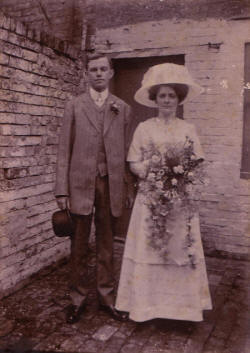 |
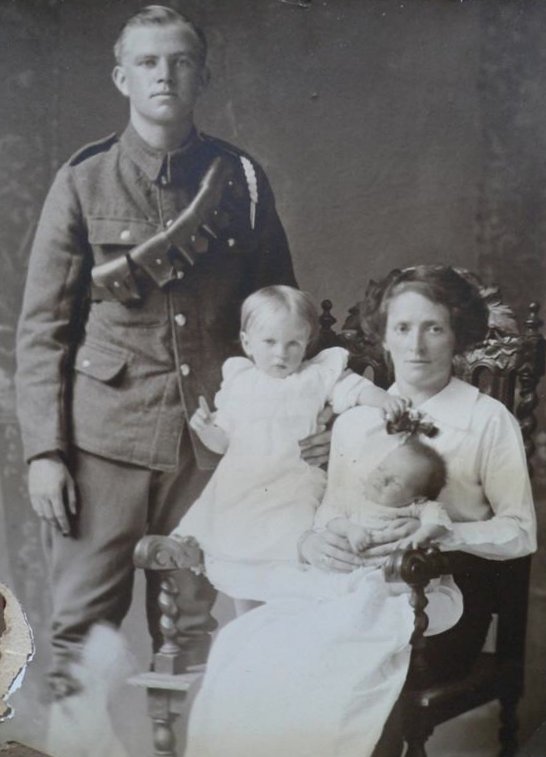 |
Arthur and Florence pose with their children Imelda and Sydney.
Unfortunately the date is unknown although it appears that Sydney, in his mother’s arms, is a young baby at the time. Tragically, Sydney died in 1919 and his death is registered in Cheltenham in the 2nd quarter of 1919. Sydney is buried in Cheltenham Cemetery.
|
| |
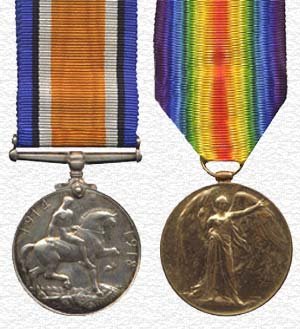 |
|
Arthur’s Medal Index Card, above, which confirms his entitlement to two Campaign Medals of the Great War – the Allied Victory Medal and the British War Medal, shown in the picture on the right. It appears that Arthur did not proceed to France prior to 1st January 1916 as he was not awarded the 1914/1915 Star. The card confirms his Regimental Number as 338658, his rank of Gunner and his Corps as the TF RGA (Territorial Force – Royal Garrison Artillery). Men serving in the Territorial Force usually were allocated a six digit numbers in 1917 though Arthur could well have enlisted or called up in 1916 or 1917. Certainly as a married man he would have been called up late in the Derby “Group” System. The campaign medals (known at the time as The Squeak and The Wilfred) were sent to Florence on 2nd May 1922 by the Royal Garrison Artillery Record Office located at South Front Barracks at Dover. She would have have to sign the official receipt form and return it to Dover. |
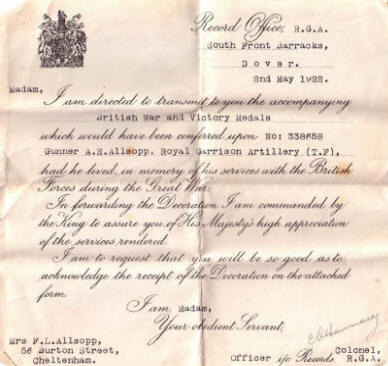 |
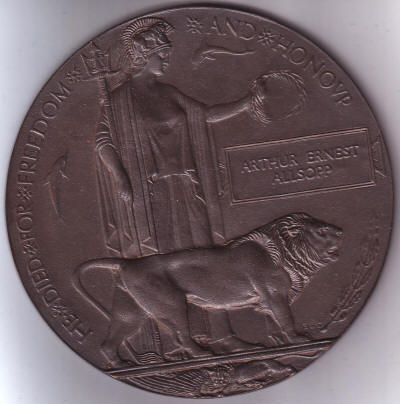 |
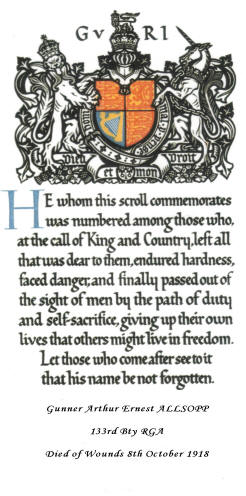 |
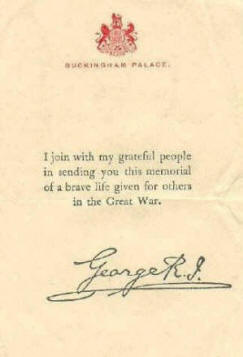 |
| In addition to Arthur’s Campaign Medals, Florence would also have been sent his Memorial Plaque (known colloquially as the “Dead Man’s Penny”), a Memorial Scroll and a covering letter bearing King George’s signature.
In 1916 the Government set up a committee “to consider the question of a memorial to be distributed to the relatives of soldiers and sailors who fall in the war…..”. It was decided that the commemoration should take the form of a bronze plaque and the inscription “He Died For Freedom” would form part of the design. In addition to the plaque, a scroll with a suitable inscription would be issued. A public competition to design the plaque was authorised and the winning design from over 800 entries from all over the Empire was announced in The Times on 20th March 1918. The design, “Pyramus”, by Edward Carter Preston, was put into production in December 1918 and over 1 million were produced. The plaques commemorated those men and women who died between 4th August 1914 and 10th January 1920 and up to and including 30th April 1920 for those who died subsequently from attributable causes. The plaques themselves were dispatched separately from the Scroll in a stiff card wrapping enclosed within white envelopes bearing the Royal Arms. Both memorials were accompanied by a letter from King George V which bore his facsimile signature and read as follows: “I join with my grateful people in sending you this memorial of a brave life given for others in the Great War. George R.I. The scrolls started to be manufactured in January 1919 and were sent out in seven and a quarter inch long cardboard tubes. The Memorial Scroll, in the middle, has been made up to represent what Arthur’s Scroll would have looked like. |
||
|
Arthur is buried in the Bucqouy Road Cemetery, Ficheux, Pas de Calais, France. The Cemetery is situated on the D919 heading south from Arras to Ayette, on the right hand side of the road 9 kilometres from Arras, just before a crossroads with the D36 between Ficheux and Boisleux-au-Mont. The grave location in the Cemetery is Plot IV, Row E, Grave 24.
Arthur’s record at the Commonwealth War Grave Commission can be viewed here. |
|
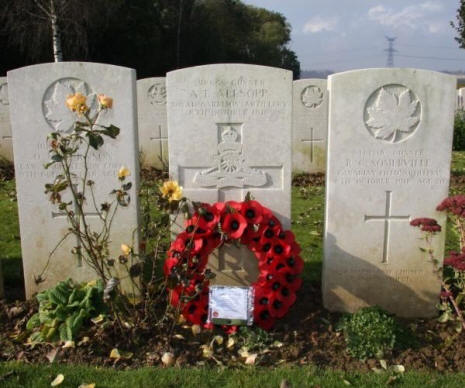 |
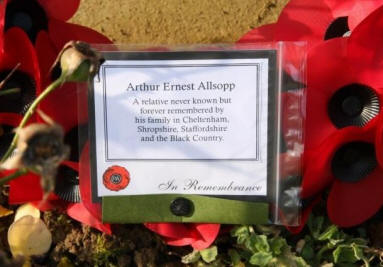 |
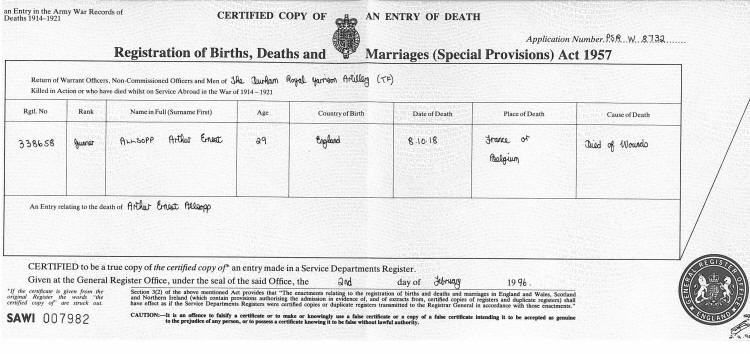 |
|
|
Arthur was a prolific letter writing whilst he was serving in France and several of his letters to Florence just prior to his death have been transcribed by Beverley Young – Florence’s granddaughter. |
|
| 16th Sept 1918 Well Dear I hope the Babs are both going on alright and not giving you too much trouble. I have great hopes of being home for good before long now, as it is all the talk about it soon finishing up this year. I have heard talk of it being 21 days starting from Oct the 1st have you heard anything more about it? I hope that it’s right it will give more chance to get a few jobs done at home. They are still going on leave, sending three or four some days. I don’t know if any have gone today but they won’t be long getting through them. Once they make a good start then I shall soon be home, but I think myself that it will be somewhere near the same time as last year that I got home. Well Dear I think this is all for this time, please remember me to all at home. I will leave now with fondest love and kisses, from your loving husband Art. xxxxxxxxxxxxxxxxxxxxxxxxxxxxxxxxxxxx
|
|
| 18th Sept 1918 Well Dearest we are getting a good drop of rain again this last day or so. Myself and a mate have got a small hole in the ground now nearer the cook house, as the place down in the village was getting rather hot one way and another. You had to be able to find head cover over as the rats ran over you at night. Had many a whack at them with half a brick or a tin hat, anything that came in reach of your hands but we are alright here, doing very little. Talk of going out on ? again, could do with one after the running we have been doing. I think they are doing very well again now further south, they talk of having him out of France this year but I have my doubts about it. We have been getting a bit better food this last week or so had boil rice most every day or course it is not very sweet but it helps fill you up and you know that I like rice and can most always get some oatmeal from the cook house but the job is getting something to sweeten it. We like to get syrup but that’s a job to get at times but don’t you worry we don’t do so bad now my love. I don’t think that you will see so much of a change in me when I come home this time, only I think that I have got a little bit better looking, well I thought so have just had a wash and a shave.
|
|
| 4th Oct 1918 (2 days before he died) Did you understand what I meant in my last letter where anyone round home that their husband has been here just lately, they will tell you all about it, but from what I can make out of it they give you ten half warrants? (previous letter mentioned free railway passes, so I presume this is what he means here) to go somewhere while on leave, but you have got to say where you want to go so they can make them out by what I understand. Don’t know much about it so you had better let me know if you want to go anywhere. Home is good enough for me. I wonder what Mel (their daughter) would say if she knew you never sent her letter to me. I bet she thought herself very ? writing all that to her Dad. I shall be very glad when I can get home for good and hear some of their chatter. You are quite right about the times that I have been out here. It is a bit rough, only seeing you once in all that time, but there are others out here worse off than me. I shall be able to make up for it that’s one thing certain. |
|
|
Arthur’s final letter to Florence – written on 6th October 1918, just two days before his death. |
|

Page 1 |

Page 2 |

Page 3 |

Page 4 |

Page 5 |

Page 6 |

Page 7 |

Page 8 |
Page last updated: 5th August 2010
| Home Page | Area Covered | War Memorials | Roll of Honour | Uncommemorated | Cemeteries | Investigations | Observations |
| Commemorations | Images | Facts and Figures | Victoria Crosses | The Book | Memorial Scroll | Links | Acknowledgements |
| Latest News | Timeline | VAD Hospitals | Site Map |